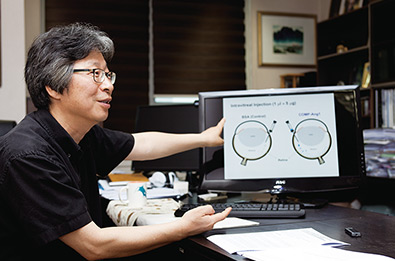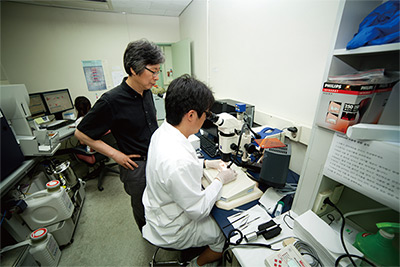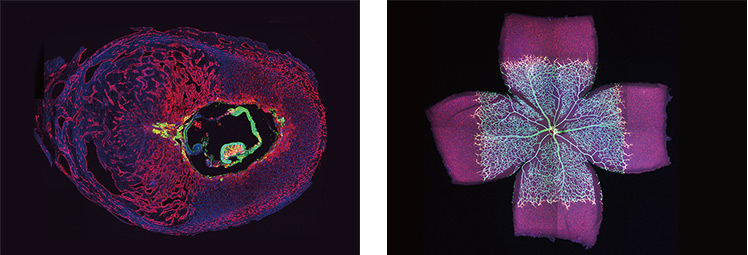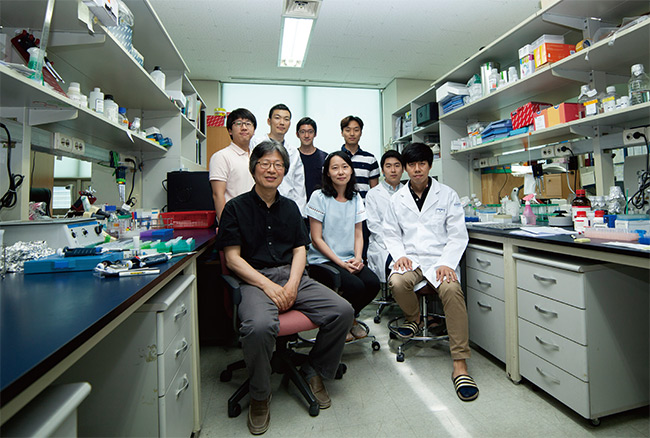주메뉴
- About IBS 연구원소개
-
Research Centers
연구단소개
- Research Outcomes
- Mathematics
- Physics
- Center for Underground Physics
- Center for Theoretical Physics of the Universe (Particle Theory and Cosmology Group)
- Center for Theoretical Physics of the Universe (Cosmology, Gravity and Astroparticle Physics Group)
- Dark Matter Axion Group
- Center for Artificial Low Dimensional Electronic Systems
- Center for Theoretical Physics of Complex Systems
- Center for Quantum Nanoscience
- Center for Exotic Nuclear Studies
- Center for Van der Waals Quantum Solids
- Center for Relativistic Laser Science
- Chemistry
- Life Sciences
- Earth Science
- Interdisciplinary
- Center for Neuroscience Imaging Research (Neuro Technology Group)
- Center for Neuroscience Imaging Research (Cognitive and Computational Neuroscience Group)
- Center for Algorithmic and Robotized Synthesis
- Center for Genome Engineering
- Center for Nanomedicine
- Center for Biomolecular and Cellular Structure
- Center for 2D Quantum Heterostructures
- Center for Quantum Conversion Research
- Institutes
- Korea Virus Research Institute
- News Center 뉴스 센터
- Career 인재초빙
- Living in Korea IBS School-UST
- IBS School 윤리경영


주메뉴
- About IBS
-
Research Centers
- Research Outcomes
- Mathematics
- Physics
- Center for Underground Physics
- Center for Theoretical Physics of the Universe (Particle Theory and Cosmology Group)
- Center for Theoretical Physics of the Universe (Cosmology, Gravity and Astroparticle Physics Group)
- Dark Matter Axion Group
- Center for Artificial Low Dimensional Electronic Systems
- Center for Theoretical Physics of Complex Systems
- Center for Quantum Nanoscience
- Center for Exotic Nuclear Studies
- Center for Van der Waals Quantum Solids
- Center for Relativistic Laser Science
- Chemistry
- Life Sciences
- Earth Science
- Interdisciplinary
- Center for Neuroscience Imaging Research (Neuro Technology Group)
- Center for Neuroscience Imaging Research (Cognitive and Computational Neuroscience Group)
- Center for Algorithmic and Robotized Synthesis
- Center for Genome Engineering
- Center for Nanomedicine
- Center for Biomolecular and Cellular Structure
- Center for 2D Quantum Heterostructures
- Center for Quantum Conversion Research
- Institutes
- Korea Virus Research Institute
- News Center
- Career
- Living in Korea
- IBS School
News Center
| Title | Leading the first IBS Center in basic medical sciences | ||||
|---|---|---|---|---|---|
| Name | Department of Communications | Registration Date | 2015-09-22 | Hits | 4269 |
| att. |
 k_thumb.jpg
k_thumb.jpg
|
||||
|
Leading the first IBS Center in basic medical sciences On July 1st, 2015, the Institute for Basic Science (IBS) launched the Center for Vascular Research, the first IBS research center in the field of basic medical sciences. The Center is led by Gou Young Koh, a professor at Korea Advanced Institute of Science and Technology (KAIST). Since beginning his research in basic medical sciences to develop new drugs for treating intractable diseases, he has achieved world-renowned outcomes in vascular biology, some of which have the potential to serve as a basis for developing anticancer drugs that inhibit the growth and metastasis of tumor cells. This 4th issue of IBS Research features an interview with him, focusing on his impressive research career and his ambitious plan for the Center. “I feel honored and responsible at the same time
as a basic medical scientist. I hope to motivate
junior scientists in this field to further undertake
their research.” Successful cardiac cell implantation into a living heart
“Back in the 1980s, my professor said that by
conducting research in basic medical sciences,
we could identify the fundamental causes of
diseases and develop new therapeutic strategies,
and that this would eventually help us treat
patients with intractable diseases. He was a
huge inspiration to me, and that is primarily
the reason why I decided to pursue a career in
this field,” said Director Koh. He received the
17th Wunsch Medical Award from the Korean
Academy of Medical Sciences and Boehringer
Ingelheim Korea in 2007, almost a decade after
Kyung Woo Cho, his professor at Chonbuk
National University Medical School, received
the same award. “COMP-Ang1” distributed to researchers in other countries
Director Koh is a highly established scientist in
the field of vascular biology. The generation,
differentiation, and regeneration of the blood
vessels are fundamental to maintaining life.
He has been thrust into the global spotlight for
identifying angiogenesis-promoting proteins and
their mechanisms. “DAPP,” a new solution for inhibiting tumor angiogenesisDirector Koh has conducted intensive research
on tumor angiogenesis. To accelerate its growth,
a tumor stimulates blood vessel generation to
obtain sufficient oxygen and nutrients. These
new vessels are used to feed tumor cells with
nutrients and also to spread them around the
body. Recently, a vascular targeting therapy has
emerged as a popular anticancer therapeutic
option. Unlike traditional therapies, which
directly attack tumor cells, this new therapy
targets tumor vessels. It cuts off pathways
that deliver nutrients and spread tumor cells,
thus starving the cells to death or inhibiting
metastasis.
Research on the blood vessels of different organs as well as lymphatic vesselsThree to four years ago, Director Koh started basic research on the generation, differentiation, aging, integrity, and regeneration of the blood vessels in different organs such as the eye, thyroid glands, lungs, intestines, uterus and adipose tissues. 80~90% of the graduate students under his direction and supervision were house staff from various hospital departments and were participating in Director Koh’s research as part of their mandatory military service. Based on this diversity, they could conduct in-depth research on the blood vessels of individual organs on the molecular and cellular levels after completing a short-term training program. In doing such pioneering research, the Center for Vascular Research is able to fiercely compete with some of the American and European institutes including Germany’s Max Planck Institute for Molecular Biomedicine. Director Koh explained in more detail why blood vessels are important in the therapeutic treatment. “Each organ undergoes different processes in terms of the generation, differentiation, and reconstruction of blood vessels, and each blood vessel contains different conditions as they are involved in different types of homeostasis or diseases such as tumors and infections. We can gain insight regarding efficient vascular regeneration, as well as therapeutic strategies for vascular diseases by conducting research on the generation, differentiation, integrity, and modulation of different blood vessels depending on each organ’s type of homeostasis or disease.” In addition, Director Koh is interested in exploring the roles of lymphatic vessels and pericytes. Blood vessels and lymphatic vessels are considered the water and sewer pipes of the human body. He said, “There are approximately 600 lymph nodes in the human body. Pathogenic viruses and bacteria, immune cells, and tumor cells travel through lymphatic vessels scattered throughout the body and arrive at lymph nodes, leading to immune responses.” He added, “I am planning to conduct research focused on the roles of lymphatic vessels when immune cells interact with antigens in lymph nodes.” The role of pericytes is another topic to be explored. Pericytes wrap around endothelial cells in capillaries where the exchange of gases, nutrients, and waste takes place. Recent findings indicate that they contribute to the differentiation and integrity of blood vessels by secreting special kinds of molecular substances. Moreover, the Center for Vascular Research plans to embark on the demanding task of bioimaging secreted molecular substances. Director Koh said, “Using the images, we are planning to observe how secreted substances, such as capillary hormones and growth hormones, enter blood vessels and modulate them. To do that, we will collaborate with bioimaging researchers to develop effective methods such as the fluorescent staining of the substances.” The Center plans to conduct cardiovascular research as well. Emphasizing that the heart is a part of the blood vessels, Director Koh explained, “The pathogenic role of blood vessels is critical in cardiovascular diseases. Even when implanting myocardial stem cells, angiogenesis must take place simultaneously.” When he was a research associate at the Krannert Institute of Cardiology, Indiana University, Director Koh carried out a successful trial of cardiac cell implantation for cardiac regeneration, which was the first time it had been done in the world. These series of successful implantations of cardiac stem cells and muscle cells has laid the foundation for myocardial regeneration research using stem cells for the past 20 years. Myocardial regeneration research using stem cells is a highly competitive global field. Director Koh said, “For the next ten years, I will conduct basic research to generate cardiac stem cells appropriate for myocardial regeneration and identify their characteristics, and at the same time I will undertake applied research to develop efficient implantation methods.”
Suggestion: a joint lab with the Max Planck Institute for Molecular BiomedicineHaving a desire to develop new drugs, Director
Koh has long stressed the importance of the
bioindustry. Some experts call the industry
“the Fourth Wave” and estimate that by 2030,
the global antibody drug market will reach
about 500 trillion Korean won (approximately
423 billion U.S. dollars). Director Koh said, “The
development of protein therapeutics is the
biggest field. Because basic research in this
field is highly likely to find its application,
we are participating, directly and indirectly,
mortality rate of sepsis is expected to drastically
decrease. Recently, we have developed an
antibody for protecting vascular endothelial
cells from pathogen-induced damages through
collaborative research.” |
|||||
| Next | |
|---|---|
| before |
- Content Manager
- Public Relations Team : Yim Ji Yeob 042-878-8173
- Last Update 2023-11-28 14:20















